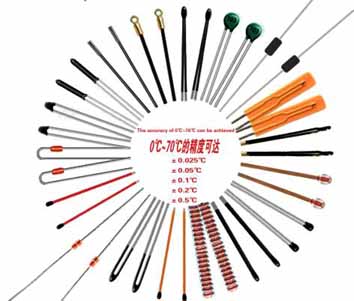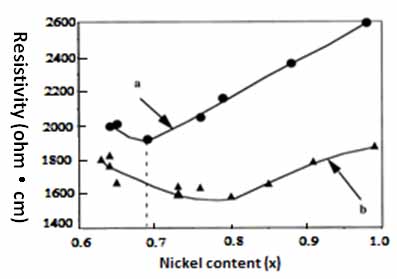The conductive mechanism of NTC thermistor

The electron hopping model is currently a widely recognized and accepted conduction mechanism in Ni-Mn-O series NTC thermal ceramics. The model believes that there are two conditions for electronic conduction in this system:
(1) The valence state of metal ions can be changed;
(2) Metal ions with variable valence occupy the same position in crystallography. For the Ni-Mn-O material system, it generally contains variable valence Mn ions, and there are many valence states such as +4, +3, +2. Among them, Mn 4++ and Mn3+ ions generally tend to enter the B site in the spinel structure, while Mn2+ ions tend to enter the A site. In the spinel structure, since the distance between the B-B sites is slightly smaller than the distance between the A-A sites, electrons will jump between the shorter B site Mn4+ ions and Mn3+ ions, resulting in skipped conduction.
Take NixMn3-xO4(03O4, well-known Mn3O4 is an insulator with very high resistivity. Its cation distribution is generally [Mn2+]A[Mn3+Mn3+]BO4. It can be seen that there is only a single cation of Mn3+ at the B site, and no other valence Mn ions exist. Therefore, the electrons cannot conduct jump conduction, so the resistivity of Mn3O4 is very large, and the conductivity is an insulator. When Ni is doped into Mn3O4, it generally exists in the state of Ni2+ ions. It can be known from Table 1 that Ni2+ ions preferentially occupy the octahedral interstitial position (OSPE) as high as 22.8, so Ni2+ ions preferentially enter the B site. After the Ni2+ ion enters the B site, in order to maintain the neutrality of the electricity price, the Mn3+ ion located at the B site must be changed into a higher valence Mn4+ ion at this time. At this time, the cation distribution of NixMn3-xO4 can be written as: [Mn2+]A[Ni2+xMn4+xMn3+2-2x]BO4, it can be seen that there are two valence ions of Mn4+ and Mn3+ at the B site, so electrons can jump between Mn4+ and Mn3 ions Conductivity. The resistivity decreases, and as the content of Ni doped increases, the resistivity continues to show a downward trend. Theoretically, the conductivity can be calculated by the following formula:
Among them, 5 is the concentration of the octahedral position, is the electron jumping distance, is the frequency of the thermal vibration of the lattice related to conduction, is the Boltzmann constant, and is the basic charge of the electron. [Mn4+] and [Mn3+] are the concentrations of Mn4+ ions and Mn3+ ions in the octahedron, which are the barriers to be overcome for electron jumping. Theoretical calculation shows that when [Mn3+]=[Mn4+], that is, x=2/3, the resistivity will have a minimum value. If you continue to increase the content of Ni element, the resistivity will gradually increase. Fritsch systematically studied NixMn3-xO4 (0.6

(a) Vacuum evaporation coating (no heat treatment process);
(b) Screen printing process (silver burning at 850°C).





